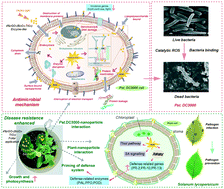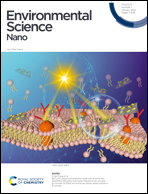Bi2O3/TiO2@reduced graphene oxide with enzyme-like properties efficiently inactivates Pseudomonas syringae pv. tomato DC3000 and enhances abiotic stress tolerance in tomato†
Abstract
This study aimed to evaluate the potential role of Bi2O3/TiO2@reduced graphene oxide (rGO) in the antibacterial activity of the typical plant pathogenic bacteria Pst.DC3000 and the enhancement of tomato resistance to pathogenic bacteria. The in vitro antibacterial test showed that 4%rGO-(Bi2O3–TiO2) with a minimum inhibitory concentration of 1280 μg mL−1 had an inactivation efficiency of 6 log (>99.9999%) for Pst.DC3000 within 150 min under visible light conditions, which far exceeded the other types of nanomaterials under study. Its good peroxidase-like and superoxide dismutase-like characteristics and ability to tightly bind to the lipopolysaccharide of the bacterial outer membrane made it adhere to the bacterial surface and produce a large amount of reactive oxygen species [˙O2−, hydroxyl (˙OH) and H2O2] for in situ sterilization. This feature changed the permeability of the cell membrane and significantly down-regulated the virulence genes (hrpS, corS, iaaL and flgG), destroying the pathogenicity of the bacteria. Incredibly, 1280 μg mL−1 (100 μL per 1 g leaf) 4%rGO-(Bi2O3–TiO2) foliar spray substantially alleviated the pathogenicity of Pst.DC3000, and both the growth and photosynthetic function were improved. Simultaneously, the increase in thiols and defense-related enzyme activities (PPO, PAL and POD increased to 4.5, 30 and 10 U g−1 FW) indicated that 4%rGO-(Bi2O3–TiO2) significantly enhanced the tomato resistance to Pst.DC3000, and the 2.39- and 3.35-fold up-regulation of PR-2 and PR-13 gene expression verified the enhancement of disease resistance. In conclusion, in vitro and in vivo experiments showed that 4%rGO-(Bi2O3–TiO2) stood out in plant resistance and disease resistance and has potential application value in agricultural nanotechnology.

- This article is part of the themed collections: Nano-bio interactions and Environmental Science: Nano Recent HOT Articles


 Please wait while we load your content...
Please wait while we load your content...